| International Woodwinds always has great saxophones on display. I came very close to buying the silver bass sax to the right of this photo. However, the new thing that struck my eye this years was the contrabass clarinet in the center. I have seen contrabass clarinets in many configurations - but this one was new to me. |
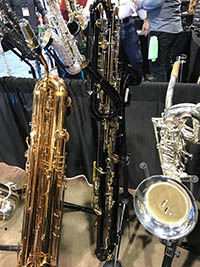 |
| Of course, if you want to really sparkle when you play, you will need one of these saxophones from CE Winds! Be careful not to scratch yourself, though! |
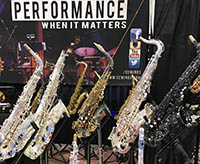 |
| Now that I own many trumpets, including a C-trumpet and a piccolo trumpet, perhaps I need one these contrabass trumpets from SIA ES projekti. It uses a tuba mouthpiece but has a much raspier tone than a tuba. One of the salesmen at this booth told me this is a traditional Latvian instrument. |
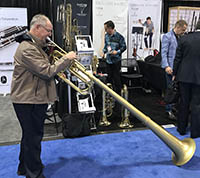 |
| If you need a really classy keyboard stand, how about one of these grand-piano-looking ones from Dutchgrand. A first I was skeptical. After all, why would I want a heavy wooden stand for use on gigs. However, this stand is not wood. It is made with very lightweight and strong materials and weights about 30 pounds - less than most 88-key electric pianos! In addition, the space space "under the lid" can accommodate additional sound equipment and amplifiers, making for a very tidy gig setup. on top of all this, it folds up int a very compact unit that is easily packed away. |
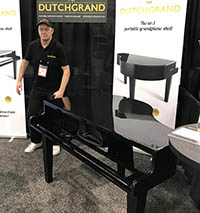 |
| Here is the latest product from Schoenhut, the longtime famous makers of toy pianos - the kind that have been many child's introduction to the piano for hundreds of years. This one is a MIDI controller! Don't worry, they still make the "real" toy pianos The new digital models allow an option for parents whose children are used to digital sounds. This demo model was driving an iPad with a piano app. Before I sat down, I verified with the woman there that I would not break the bench. She told me that US toy laws are so strict that just about nothing could break the bench! |
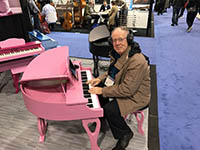 |
| I have reported on instruments at the NUVO booth before. They did not have anything new this year - but they displayed an impressive set of current products - all made entirely of plastic. As Tom Lehrer once remarked: "to think of all the marvelous ways they're using plastics nowadays!" I tried each of these instruments and I am still very impressed. Of course, they are targeted to children and are pretty much indestructible. |
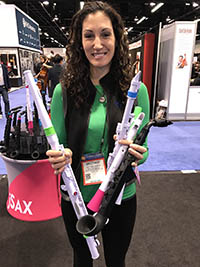 |
| This year, my ticket was graciously provided by the Kanstul company that makes fine brass instruments. In fact, I purchased a custom cornet from them at the 2016 NAMM. They told me to be sure to try out the compact brass instruments at the Wessex booth. It was good advice. Wessex was displaying several "micro tubas." This one is an F tuba. It played remarkably well. It was quite quiet, since it is intended as a travel practice instrument. However, it could easily be used in a small brass group - and would be a pleasure to play in a strolling group. |
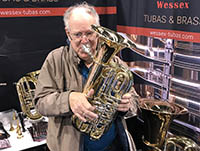 |
| This is a product I had never considered It is a trumpet dehumidifier. It gently blows heated dry air through your trumpet while it sits in the case. The coolest part is its name: the "Horn Blower." It also comes in a saxophone model. |
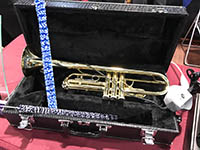 |
| I reported on the Cool Wind tuba last year - but this year it also comes in silver! This photo shows an array of plastic instruments in various sizes. The most interesting thing for me about Cool Wind is what is not in the photo. They are working an a French Horn that should be out next year! |
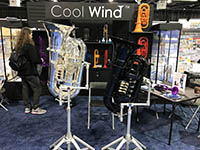 |
| Not everything that is new and creative at NAMM is high-tech. Here is a drum practice pad from Prentici. It is built in two pieces. he joint between them is cut on an angle and to two pieces are joined with Velcro. You can take them apart and re-attach them in multiple ways to get different pad angles for practicing. |
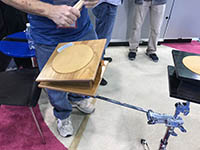 |
| Normally, when I indicated "brushes" in a drum part, I want things quiet. However, this product, by Hybrid Brushes, allows brushes to be played very loudly by providing an adjustable bar behind them. |
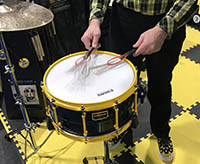 |
| Here is another low-tech idea. It is the ISOVOX personal recording booth. I can understand this one since I have had trouble isolating vocal tracks in my own home studio. I suppose it is also quite portable so perhaps we can finally saddle our vocalists with their own equipment! |
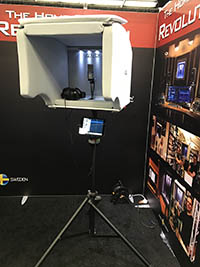 |
| The idea for string sustains using a rotating wheel goes back several hundred years at least. I have seen such devices in museums. However, this is the first attempt I have seen at a practical one for performance use. It comes from Gizmotron, LLC. They make units that attach to guitars and basses. You use a non-marring adhesive to attach to mounting plates and then the sustain using attaches in seconds. There are keys over each string for sustaining notes and it is quite easy to move from sustaining to strumming or plucking. |
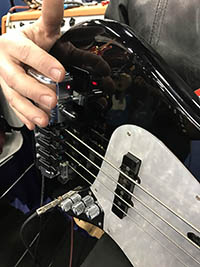 |
| Here is an interesting idea from Scherpler. Now that we are all used to having software mixers on our computers that we can configure any way we want, we can also have hardware mixers with similar flexibility! I am not sure what the actual advantage is - but its certainly cool. The secret is a bus architecture that allows the user to strap columns together in any way that makes sense for the application. |
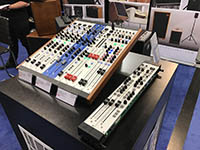 |
| From a company with obvious name "FIngerWeights" comes a product that is, well finger weights. The idea here is to help students (and professionals) train for keyboard or guitars with adjustable weights. They even gave me a free sample! They are comfortable and you can actually play using them - perhaps it can make you louder? I'll have to try that later. |
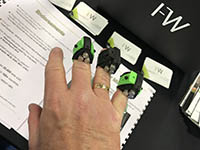 |
| From another company with an obvious name, "Unplug," comes a small battery-powered effects processor for acoustic guitars. This is really quite cool. It attaches to the back of a guitar using magnets so it does not damage the instrument. It picks up the sound from the guitar and gives the play effects like reverb, echoes, and flanging - with just enough volume to make sense with the acoustic instrument. You can then mike the entire thing, of course. |
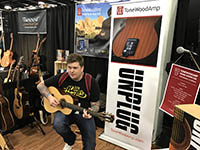 |
| I have too many friends who have had guitars or banjos damaged during airline transportation. Even if you manager to take the instrument into the passenger cabin, it can still be damaged by other passengers. Aeris Protective Packaging has developed a system to help. It is made of extremely durable plastic, formed into an array of parallel tubes. You wrap you instrument and then inflate the tubes. The resulting assemble than goes into a regular cardboard shipping box. You can now put in in the airplane's luggage compartment or simply put it in the mail. |
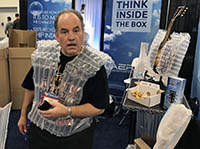 |
| This piano from Valente is actually a prototype if a new electro-accoustic instrument. Like the old Fender Rhodes or Wurlitzer Electric, this instrument has a real keyboard action that strikes reeds with hammers. Its sound is quite different than these other two, however. I really liked the touch of this one and look forward to it coming on the market. |
 |
| This Celtic harp immediately caught my eye because of what it does not have. It is missing any curved frame parts - and also it is missing a resonator. This is a hard-bodied harp made by Xelta. The get around needed a curved frame bu using different gauge of wires as you move up the scale. This works because it is not meant to be an acoustic instrument. They can re-level the scaling electronically in the amplification. The straight frame should make it much less expensive to manufacture too. By the way, they also have a full pedal-harp version, but it was not on display at the show. |
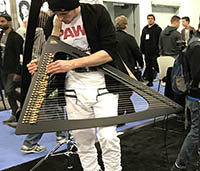 |
| The new buzzword this year at NAMM was definitely "cloud." Tones of companies now have "clouds" and they seem to mean something different in each case! The Roland Cloud appears to allow the user access to a myriad of software instruments online. |
 |
| I always enjoy the funky new silly piano shapes at NAMM. This year it was this roadster from Seiler Pianos. When this woman was done, I sat down and played "In My Merry Oldsmobile." |
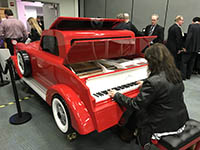 |
| Here is another cloud! This is a "recording cloud" by BandLab. This one is free and sounds very useful. It allows users to share audio tracks on collaborative recording projects It can tack tracks from the major digital studio programs including Pro Tools and Digital Performer. I might give this a try. |
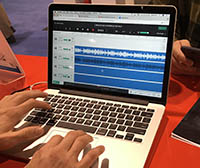 |
| How can you live without a tuner in the shape of a cut little animal! This tuners, from IMS Technology, are also VERY small. They are about an inch and a half tall. |
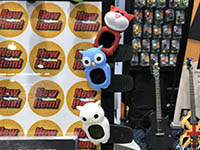 |
| This prototype MIDI controller keyboard from Alpha Pianos was just about the coolest looking keyboard instrument I saw at NAMM this year. The keys are pipe organ quality fine wood and the action is excellent. I can;t wait for the four-manual version to be released! |
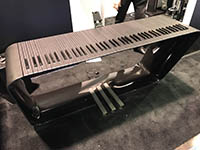 |
| This product finally realized the full potential of the keyboard workstation. It is really a keyboard workstation. It is a full sized desk with a piano keyboard drawer from Suzuki. The disk includes built-in speakers too. |
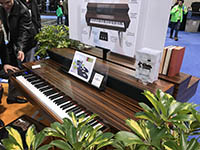 |
| Ooh - its another cloud! Here is the Sibelius Publishing Cloud. Sibelius allows users to publish sheet music to the cloud and offer it for sale. They take a percentage (I don;t know how much.) |
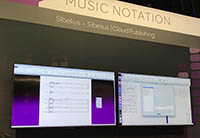 |
| This product would win my mathematics award for the year. My son, Elliot, told me about this. As a professional composer, he has watched Melodyne being used in high-end studio settings. It can turn a horrible vocal track into something that is very commercially passable. It dies this my intelligently monitoring the pitch of the vocal and matching it to the other tracks. However,r it can do a lot more. The developer claims it can take recordings of multiple instruments with multiple notes and separate them into individual tracks. I consider this one of the great unsolved mathematical problems in music. It is a but pricey - but I might by it to see what it can do. They did not have a special prices at the NAMM show - since they did not have carry heavy things back with them! |
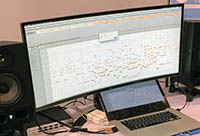 |
| OK, the only thing cool about these drums is the puck-rock inspired symbol stands. They are very cool in a way that I will never use them myself. Th e company name is equally interesting: Sawblade! |
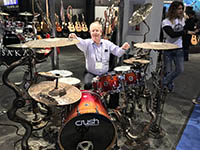 |
| My professional composer son, Elliot, was with me at NAMM on Sunday and this was the product he most wanted to see - Dorico. It is a new high-end music publishing system from part of the original Sibelius design team. Evidently, when Sibelius was bought out about five years ago, the people were hired by Steinberg to design a new system that corrects all the problems that both Sibelius and Finale have had for a while. Dorico is their answer and it is new this year. I picked up a 30-day trial license so I can try it out. |
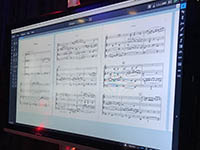 |
| How often have you been in situation where you are playing a more contemporary jazz chart and your bassoon part calls for a low A? I can answer this for myself: never! However, if you do find yourself in this situation, you now have a solution: the plastic tube low-A bassoon extension from the Geneva Group. |
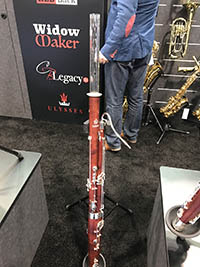 |
| Here is an instrument from a company with an unlikely name: Z. O. Industrial. It is a high Bb helicon, paying in the same range as a trombone. They had some other name for it - but its definitely a helicon. |
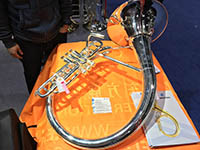 |